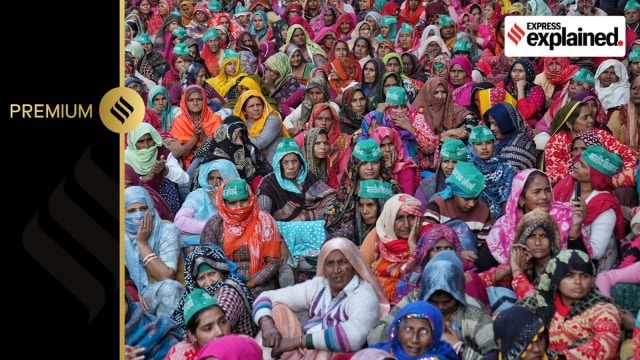Udit Misra is Senior Associate Editor. Follow him on Twitter @ieuditmisra ... Read More
© The Indian Express Pvt Ltd
Latest Comment
Post Comment
Read Comments
 The promise to double the central government's contribution to the monthly salaries of Asha, Anganwadi and women involved in preparing the mid-day meal — will have some small financial impact according to economist Dipa Sinha. (Express photo by Abhinav Saha)
The promise to double the central government's contribution to the monthly salaries of Asha, Anganwadi and women involved in preparing the mid-day meal — will have some small financial impact according to economist Dipa Sinha. (Express photo by Abhinav Saha)The latest set of five promises by the Indian National Congress, aimed towards empowerment of women, appear to be a refreshed version of its 2019 election manifesto.
In the run-up to the 2019 general election, the Congress had promised to start a Minimum Income Support Programme (MISP) or Nyuntam Aay Yojana (NYAY) if voted to power. This included a cash transfer of Rs. 72,000 a year to the poorest 20 per cent of all Indian families (roughly 5 crore households). At that time, too, the party had stated that “as far as possible, the money will be transferred to the account of a woman of the family”.
In 2019, economist Jean Dreze had pegged the total annual outgo on account of NYAY to be Rs 3,60,000 crore or around 2% of India’s GDP.
The biggest, at least in terms of the financial implications, promise among the five announced on Wednesday (March 13) is called “Mahalakshmi” and it involves transferring Rs 1 lakh every year to a woman from a poor family. However, there is no mention of the exact number of poor families it aims to target.
As things stand, India’s poverty estimates vary substantially based on different methodologies. For instance, Niti Aayog’s Multidimensional Poverty Index, pegs poverty ratio at around 11% while its CEO has reportedly claimed that poverty could be as low as 5% if one takes into account the latest data from consumption expenditure survey released last month. The World Bank pegs India’s poverty ratio at 11.3% in 2022-23 based on its international poverty line of people living at US$2.15 (or Rs 48.9 in purchasing parity terms) per day.
Economist Santosh Mehrotra says that if, for the sake of simplicity one assumes a poverty ratio of 10%, then it implies the target beneficiaries will be 14 crore families (assuming a total population of 140 crore). If one woman from each poor family is targeted — that is, 2.8 crore women — then the total outgo would be Rs 2.8 lakh crore. That’s 0.8% of India’s GDP (Rs 328 lakh crore) in 2024-25 (according to the Union Budget presented in February). If the poverty ratio is 5%, as Niti Aayog claims, the outgo will be halved to 0.4% of GDP.
Another way to estimate the financial outgo is to target the poorest of the poor families — those who have the Antyodaya ration card — the total number of beneficiaries would be slightly less. At present 2.33 families under the Antyodyay Anna Yojana. If women from each of them get Rs 1 lakh, the total annual outgo would be Rs 2.33 lakh crore — or 0.7% of India’s GDP.
The second promise — to reserve half of all government vacancies for women — will not have any additional financial burden since these are already existing vacancies.
The third promise — to double the central government’s contribution to the monthly salaries of Asha, Anganwadi and women involved in preparing the mid-day meal — will have some, albeit small, financial impact according to economist Dipa Sinha, who focuses on social welfare issues. That’s because the salary levels are fairly low.
As of March last year, there were 10.5 lakh Asha workers, 12.7 lakh Anganwadi workers and over 25 lakh mid-day meal cooks. Sinha says that these three groups get a monthly salary of around Rs 2,000, Rs 4,500 and Rs 1,000 respectively. For instance, in 2021-22, Centre spent Rs 8,908 crore on the salaries of all the Anganwadi workers — and they earn the highest salaries of the three. Doubling these amounts — say to a total of Rs 54,000 crore — is still a fairly insignificant percentage of India’s GDP (Rs 328 lakh crore).
It is difficult to estimate the exact financial burden of the fourth promise — appointing legal counsellors for women’s rights (Adhikar Maitri) in every panchayat. That’s because there is no clarity about the remuneration.
Lastly, it is also difficult to estimate the cost of building working women’s hostels in each district. Mehrotra points out that these hostels are not “free”. In other words, their operating costs could arguably be borne by the working women themselves. As far as the cost of building is concerned, it depends on how big these hostels are.


